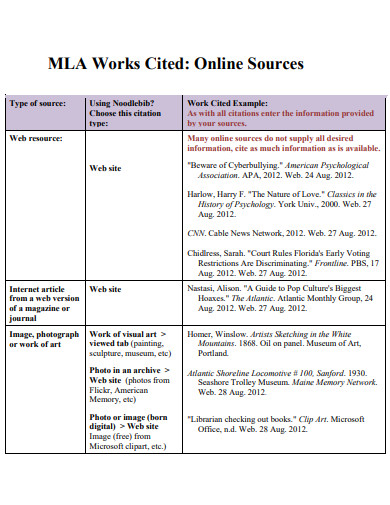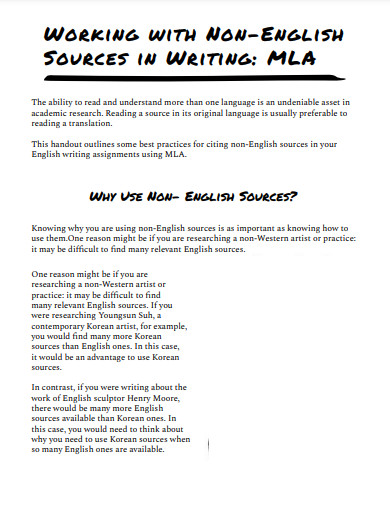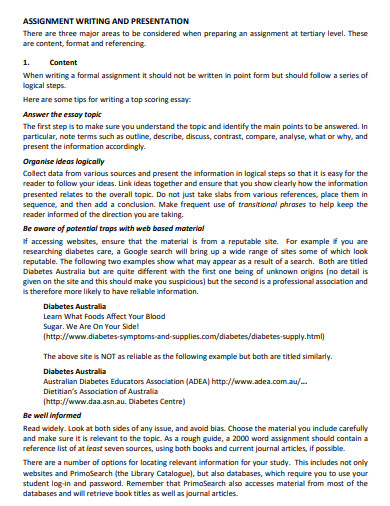24+ MLA Writing Examples to Download
Effective academic writing is crucial for students to convey their ideas and research coherently, and one popular writing style used in many disciplines is Modern Language Association (MLA) Writing. Whether you’re preparing an MLA Format essay, crafting an introduction or conclusion, creating a cover page, or organizing a bibliography, understanding the principles of MLA Writing can significantly enhance your scholarly work. In this article, we will explore the definition of MLA Writing, provide a step-by-step guide on how to write in MLA, address frequently asked questions, and equip you with the tools to navigate this style with ease.
1. MLA Bibliography Template

2. APA And MLA Writing

smsu.edu
3. Differences and Similarities APA And MLA Writing

acc.appstate.edu
4. MLA Style for Academic Work

mtroyal.ca
5. MLA Writing Online Source

nwtc.edu
6. MLA Source Work Cited Writing

maine.gov
7. MLA Writing Example

cccti.edu
7. MLA Writing Handbook

pearson.com
8. College MLA Writing

upla.cl
9. MLA Document Writing

upla.cl
10. MLA Cheat Sheet Writing

vwu.edu
11. MLA Research Paper Writing

depts.washington.edu
12. MLA Manuscript Writing Formatting

upla.cl
13. MLA Text Citation Writing

publicwebuploads.uwec.edu
14. MLA Popular Source Writing

mvsu.edu
15. MLA Annotated Bibliography Writing

delmar.edu
16. MLA Notes Writing

wwnorton.com
17. MLA Writing Template

accounts.smccd.edu
18. MLA 8 Terms Writing

nr.edu
19. Inclusive Writing in MLA

sjsu.edu
20. Non-English Writing in MLA

writingcentre.ecuad.ca
21. Writing and Citing in MLA Style

library.macewan.ca
22. Writing a Paper Using MLA Documentation Style

cuesta.edu
23. Assignment Writing and Presentation MLA

avondale.edu.au
24. Writing in MLA Format

nsu.edu
25. General Writing in MLA

bladencc.edu
What is MLA Writing?
MLA Writing refers to the set of guidelines established by the Modern Language Association, a renowned organization dedicated to promoting the study and teaching of languages and literature. It provides a standardized approach to writing and documenting research in the humanities and related disciplines. MLA Writing encompasses various aspects, including citation, text structure, and formatting, ensuring consistency and clarity throughout scholarly work. By adhering to these guidelines, students and researchers can communicate their ideas effectively, attribute sources correctly, and maintain academic integrity.
How to Write in MLA
To begin writing in MLA, it is essential to understand the fundamental elements and structure of this style. By following these step-by-step guidelines, you can navigate the intricacies of MLA Writing and produce well-crafted academic papers.
Step 1: Set Up Your Document:
Start by setting up your document in a standard word processing software, such as Microsoft Word. Ensure the page layout is in accordance with MLA guidelines, including one-inch margins, double-spacing, and a legible font like Times New Roman in size 12.
Step 2: Create an Outline:
Developing an outline helps organize your thoughts and structure your essay effectively. Use the outline format, which employs Roman numerals, capital letters, and Arabic numerals to denote different levels of hierarchy within your paper.
Step 3: Write the Introduction:
Craft an engaging introduction that provides essential context, introduces the topic, and presents your thesis statement. This paragraph should capture the reader’s attention and set the tone for the entire essay.
Step 4: Body Paragraphs and In-text Citations:
Compose your body paragraphs, ensuring each one focuses on a specific argument or supporting point. Incorporate relevant in-text citations following MLA guidelines to acknowledge the sources of your information.
Step 5: Craft a Compelling Conclusion
Summarize your main points and restate your thesis in the conclusion. Reflect on the significance of your findings and leave the reader with a thought-provoking closing statement.
Step 6: Include a Bibliography
Create a comprehensive bibliography or Works Cited page at the end of your essay to provide complete information about the sources you cited. Follow MLA guidelines for formatting each entry, such as using hanging indents and alphabetizing sources.
FAQs
What is the purpose of a bibliography in MLA Writing?
The purpose of a bibliography in MLA Writing is to provide a list of all the sources cited in your essay, allowing readers to locate and verify the information you used.
Should I include an introduction and a conclusion in my MLA Format essay?
Yes, an introduction and a conclusion are essential components of an MLA Format essay. The introduction sets the stage for your essay, while the conclusion wraps up your arguments and provides a sense of closure.
Is there a specific format for the cover page in MLA Writing?
MLA Writing does not typically require a separate cover page. Instead, your personal information, such as your name, instructor’s name, course title, and date, should be included on the first page of your essay, aligned to the left margin.
Mastering MLA Writing is a valuable skill for students and researchers alike. By understanding the principles of citation, text structure, and formatting, you can ensure your work adheres to the rigorous standards of academic writing. Whether you’re writing an MLA Format essay, crafting an introduction or conclusion, or compiling a bibliography, following the guidelines of MLA Writing will enhance the clarity, credibility, and overall quality of your academic work.


